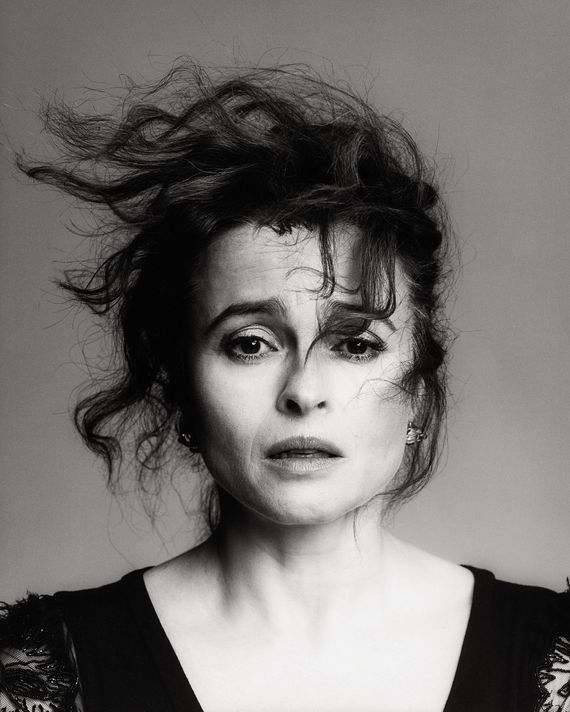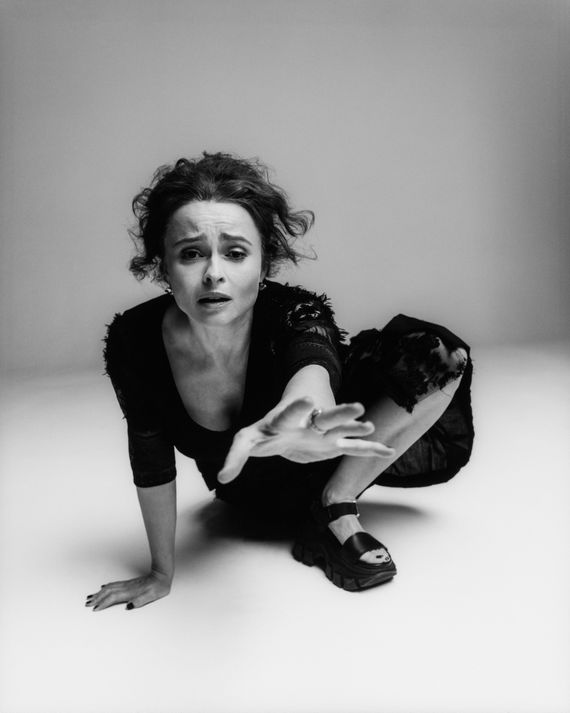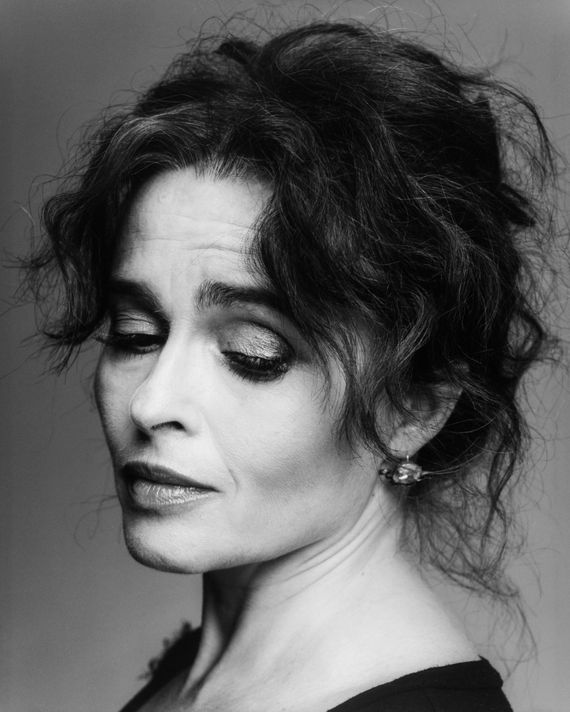
Helena Bonham Carter looks the teensiest bit bored. It’s a gray afternoon in England, and we’re in an impeccably neat garden on the set of The Crown. The Netflix series, which illustrates the tensions between the royal family’s private lives and public personae, necessarily involves many sequences full of dull protocol. Her role today: walking down a staircase. (Later she will describe it as a day in which she was essentially a “paid extra.”) When she clocks me from several yards away, Bonham Carter appears momentarily roused. Across the production’s busy membrane of actual extras, cameras, and cables stationed between us, she begins miming energetically, first at herself and then back at me as if to say, Are you the one who’s here for me? Then places are called, and she slips into her role as Princess Margaret, the often scandalous, unhappy younger sister of Queen Elizabeth.
Standing next to Bonham Carter is Olivia Colman in an ice-blue dress that fits her like a suit of armor. In character as the queen, Colman seems to disappear, replaced by Elizabeth’s implacable steadiness. Bonham Carter also uncannily replicates Margaret’s speech patterns and the minimal way she moves her body through the stultifying royal traditions. She’s wearing an olive-drab look so unremarkable that by all rights it should render her nearly invisible. But there’s a small piece of her that remains Bonham Carter. Her inerasable verve is still glowing, unmistakable in a glancing eye or a particularly sharp tilt of the head.
Bonham Carter has been acting since she was a teenager, and her particular talent has been to take supporting characters and imbue them with a vitality that cannot be ignored. This is the Bonham Carter in the Harry Potter movies as Bellatrix Lestrange, unhinged and vengeful; it’s also Marla from Fight Club, recalcitrant and sly, or any of her roles in a long line of period pieces that includes The Wings of the Dove in 1997 and The King’s Speech in 2010, both of which earned her Oscar nominations. They’re women who spill over their boundaries, who walk into a room with some uncontainable, elemental thing that threatens the natural order. On The Crown, even as the show dramatizes the wall between Elizabeth’s public image and her private life, it struggles to make the tension interesting. Margaret, though — she is defined by too-muchness, by the way her image collapsed onto her inner life. In the press, she was the misbehaving sister, painted as both more sympathetic and more shocking.
Like Margaret, Bonham Carter has often been a source of tabloid fascination. It’s something she says she cares about much less now than when she was younger. “There’s a Helena Bonham Carter who has an extraordinary life in the Daily Mail,” she says. In recent months, she has been the older woman with a boyfriend some 20 years her junior, one trope of status-quo-threatening womanhood. The British tabloids have begun calling her boyfriend a “toyboy,” the same word used in headlines about Roddy Llewellyn, the man Margaret had an affair with in the mid-’70s. In her 20s and 30s, Bonham Carter was the other woman who came between Kenneth Branagh and Emma Thompson, two brightly leonine British actors with promising careers. Then she was the mysterious romantic and creative partner of Tim Burton, a human projection of his uncanny gothic aesthetic who lived in a house supposedly connected to his via a subterranean tunnel. The tunnel has long been pointed to as proof of her strangeness, an arcane buried secret brought out into the open. “It was just, like, two houses put together,” she says.
Bonham Carter insists she is not actually that dramatic or weird, but, by her own admission, she may not be the best judge. “I have never really been able to see myself with any real clarity,” she says, sighing.
I meet Bonham Carter the next day at Netflix’s London offices, a narrow five-story building in Fitzrovia. The top floor, which we have all to ourselves, has a large, open workspace and three rooms: the Queen Elizabeth, the Prince Philip, and the Princess Margaret. The Margaret room, Bonham Carter notes, is much smaller than the Elizabeth.
She slumps down on a Netflix-red sofa, dressed in head-to-toe black: a combination of satin, lace, and faux fur, with a pearl collar accenting a fuzzy black shrug, black boots decorated with silver stars, and her characteristic bird’s nest of tangled, teased hair piled on her head. She looks like a very posh, goth fairy godmother surrounded by the remains of snack wrappers and two empty coffee cups. The double beverages, she explains, are a strategy she uses to concentrate — in an interview, between takes. “Sometimes they bring a caddie on set with all this different stimulation,” she says. “Coffee, tea, Diet Coke, ginger water.” Life during filming involves a lot of waiting around, and “by the time you’re on, you’re bored.” She consumes an “amazing amount of liquid” to keep from falling asleep.
When she describes her decision to be on The Crown, it too sounds a little like a way to combat monotony. This is how she describes the business of acting: “You’re sitting there as a passive lump in your sitting room, and somebody comes [and says], ‘Oh, do you fancy pretending to be … ?’ ” Still, The Crown’s creator, Peter Morgan, had to persuade her to take on the role of the younger royal sibling (never mind that it’s a slightly odd fit given that Bonham Carter is several years older than Colman) for the series’ third and fourth seasons, taking over from Vanessa Kirby, who portrayed the sister through her early 30s (just as Colman picked up the royal baton from Claire Foy). Bonham Carter took her time to decide. At 53, her priorities have changed: She has two children with Burton, 11 and 16 years old, and she’s aware she has only so many years of childhood left with them. “I don’t want to play lead, in all honesty,” she says. “I mean, I’d like to play a lead as long as it doesn’t take too long.”
Becoming Margaret entailed stepping into the life of a complicated woman. Bonham Carter plays the princess in her middle-aged years, when she began drinking heavily, during an emotionally abusive marriage. She turned to extramarital affairs — partly as a diversion, partly out of revenge for her husband’s infidelity. When Bonham Carter insisted on seeing a script, Morgan told her that Colman hadn’t needed to see one before signing on. “Well, fuck. Already the sibling rivalry. Like, how am I going to survive this?,” she recalls thinking. “Olivia, I’m sure, has her own criteria for doing a job, but I said, ‘I need to read a script to know if I can do it or if I can bring something.’ ” Morgan sent her the season-three finale, an episode dedicated almost entirely to Margaret’s marital spiral.
Once Bonham Carter read it, she knew she’d say yes. “When you read something and you know you have to do it, so there’s no choice,” she says, “it’s a great relief.” (She also consulted with a psychic, who told her the spirit of Princess Margaret preferred Bonham Carter over another, unnamed actress being considered for the part.)
To prepare, she read Ma’am Darling: Ninety-nine Glimpses of Princess Margaret, a book about Margaret’s press coverage, which was useful (“although I hated it”). And she did what she does with almost all of her roles: talked about it with her mother, who is a psychotherapist. “It’s not dissimilar, what we do,” she explains. “She deconstructs people, analyzes them. And I do too. I just end up pretending to be them.” She also spent some time with The Crown’s art department, selecting and working with several of the objects Margaret handles onscreen. “I live with my props,” she says, “particularly with Margaret … Her smoking stuff has to be just part of her.” She has perfect muscle memory of “the weight of a really proper gold Dior lighter.”
On set, Bonham Carter listens to Mamma Mia! in the hair-and-makeup trailer to pump herself up. “I inflict everybody,” she says. “Olivia groans at the ongoing tyranny because she’s got much hipper taste. She keeps on thinking that I like spa music.” But she finds it very difficult to be still, she says, and music, like her many beverages, helps keep her stimulated.
These days, she feels much more confident expressing needs like this. “There’s a lot of my youth that was misspent because I never said, ‘Can you let the corset out?’ I was too polite and shy,” she says. “And frightened of being a pain.” Working on The Crown, she has adopted some of Margaret’s unwillingness to oblige. “A lot of the time, Morgan will send rewrites,” she tells me. “Margaret’s convenient because I can just say no. I can pull rank. It’s the license to be powerful. ‘Don’t want any new lines now, mate. You should have given me them last week! Can’t do.’ ”
Bonham Carter seems most comfortable describing herself in the context of other people. She talks about playing characters as having a “lodger” living inside her who “rearranges the furniture.” Elizabeth Taylor, whom she portrayed in Burton & Taylor in 2013, “stuck around.” (She demonstrates this by imitating one of Taylor’s octave-spanning sighs.) Recently, she has fixated on her grandmother Violet, the daughter of H. H. Asquith, who was prime minister from 1908 to 1916. Violet was a diarist, a public speaker, an intellectual. Bonham Carter wants me to know how remarkable she was, how unusual and “rhetorical,” intelligent and liberal. “I can recognize that I can be quite passionate about certain things and words, and I thought, Oh, Violet,” she explains. “It’s only when you get really old that you begin to see yourself more objectively and go, Oh, okay, that’s where that comes from.”
Part of why Violet appeals to her is the way she resisted being placed in an easily labeled box. At one point, she asks me what adjective I’m going to pick to describe her. “Eccentric, quirky … ,” she offers, picking words that have been used to characterize her over the years. Does she object to quirky because it seems juvenile? “Tim [Burton] hated quirky,” she tells me. “He found it very lazy.” She was drawn to the way Morgan described Margaret as a character for whom “you can play the same scene ten different ways and it’d still be right because she’s so changeable. She’s so inconsistent and all-encompassing.” Margaret was defined by her duality. “She was spontaneous, but she was also incredibly conservative … She was very reserved, but, at the same time, she was very generous. But she does often oscillate between the two,” Bonham Carter says. “She didn’t know whether she was an individual or she was an icon,” and it makes her “maddening and great to play.”
Bonham Carter’s understanding of Margaret is not unrelated to her own familiarity with the disconnect between a private self and a tabloid creation. “Margaret had a terrible relationship with the press and always felt terribly misunderstood,” she says. At the same time, “she never had a say. Margaret never actually expressed herself.” She draws a comparison to the latest real-life royal drama: Prince Harry’s decision to sue the Mail on Sunday for printing Meghan Markle’s private correspondence. “Part of their public persona is being themselves,” Bonham Carter says, “and you can’t expect them to really survive through the same degree of detachment. Meghan and Harry are never going to be the people who are just the figureheads.” Their openness, she says, means “they’re going to have a much less easy relationship with the press.”
Bonham Carter likes talking about the lives of other people and sifting through their desires and motivations; she is fascinated by ambiguity and contradiction. Over the course of our conversation, she grows most animated when I ask about the many men she has worked with who have, as she puts it, gotten into “trouble.” “Which ones are you thinking of?” she asks. “Harvey?” Harvey Weinstein produced The Wings of the Dove and The King’s Speech, but there were also Roman Polanski (she was in a short film he directed in 2012) and Woody Allen, not to mention her several projects with Johnny Depp, who has also had quite a bit of — “Yep,” she interrupts, “trouble.”
“Each case is different,” she continues, but “they’re all freaks.” She sees most cases of sexual harassment and predation as bullying, as someone “taking advantage of their power.” But “you can’t condemn someone totally and say they have no worth whatsoever because they’ve been bullies. I think that would write off most of our culture,” she says. “So many peak geniuses are fucking damaged, damaging people.” Her clearest, strongest sense of the issue, the idea she returns to several times, is her confidence that people are never just one thing. “Harvey, for all that’s said, he’s very clever. He did a lot of great things for the industry as well as being appalling to people.” Still, she says, he got his “just deserts.” Although she’s willing to believe women were uncomfortable when working with Polanski, she makes it clear he was “a real gentleman” to her. (Even as she admits, after I raise the topic, that she didn’t know much about his 1978 sexual-abuse conviction, nor the sexual-assault accusations he’s faced more recently.) “Everyone’s nuanced,” she says. “Nothing is all black.” Just because good and bad often come together does not mean you can discard everything, throw it all out, and demand a history of art not made by jerks. “That work of art might have come out from a lot of pain that they’d endured as a child because they themselves have been abused,” she says.
“Everything’s all jumbled up,” she concludes.
As we talk about it, she sits up on the sofa and leans forward. Her voice, which earlier was a whisper, suddenly becomes animated. The jumble is something she seems to enjoy. The mix of good and bad and messy contradiction, like the ways in which pretending to be people can surprise you. “Acting,” she says, “is an exercise in how to stay awake.”
*This article appears in the October 28, 2019, issue of New York Magazine. Subscribe Now!





